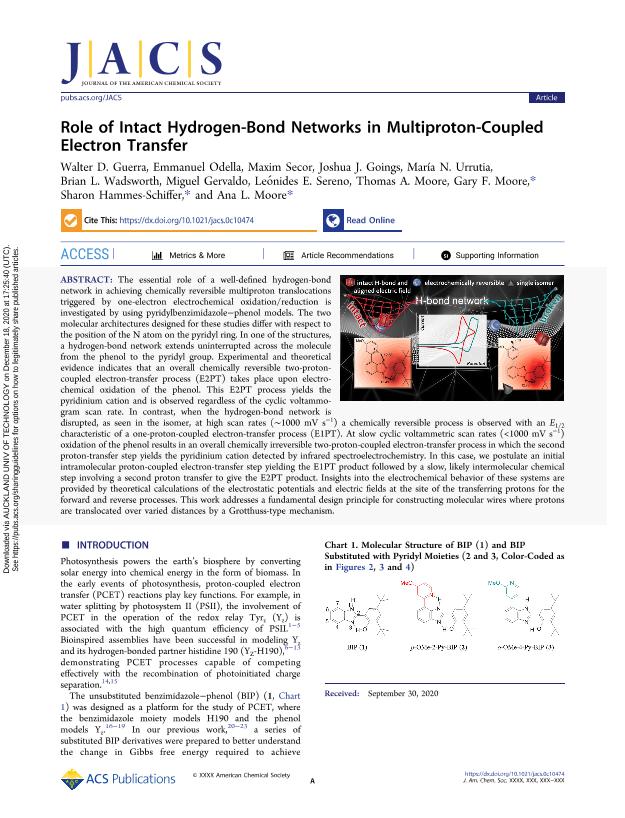Artículo
Role of intact hydrogen-bond networks in multiproton-coupled electron transfer
Guerra, Walter Damián ; Odella, Emmanuel
; Odella, Emmanuel ; Secor, Maxim; Goings, Joshua J.; Urrutia, María N.; Wadsworth, Brian L.; Gervaldo, Miguel Andres
; Secor, Maxim; Goings, Joshua J.; Urrutia, María N.; Wadsworth, Brian L.; Gervaldo, Miguel Andres ; Sereno, Leonides Edmundo; Moore, Thomas A.; Moore, Gary F.; Hammes-Schiffer, Sharon; Moore, Ana L.
; Sereno, Leonides Edmundo; Moore, Thomas A.; Moore, Gary F.; Hammes-Schiffer, Sharon; Moore, Ana L.
 ; Odella, Emmanuel
; Odella, Emmanuel ; Secor, Maxim; Goings, Joshua J.; Urrutia, María N.; Wadsworth, Brian L.; Gervaldo, Miguel Andres
; Secor, Maxim; Goings, Joshua J.; Urrutia, María N.; Wadsworth, Brian L.; Gervaldo, Miguel Andres ; Sereno, Leonides Edmundo; Moore, Thomas A.; Moore, Gary F.; Hammes-Schiffer, Sharon; Moore, Ana L.
; Sereno, Leonides Edmundo; Moore, Thomas A.; Moore, Gary F.; Hammes-Schiffer, Sharon; Moore, Ana L.
Fecha de publicación:
12/2020
Editorial:
American Chemical Society
Revista:
Journal of the American Chemical Society
ISSN:
0002-7863
e-ISSN:
1520-5126
Idioma:
Inglés
Tipo de recurso:
Artículo publicado
Clasificación temática:
Resumen
The essential role of a well-defined hydrogen-bond network in achieving chemically reversible multiproton translocations triggered by one-electron electrochemical oxidation/reduction is investigated by using pyridylbenzimidazole-phenol models. The two molecular architectures designed for these studies differ with respect to the position of the N atom on the pyridyl ring. In one of the structures, a hydrogen-bond network extends uninterrupted across the molecule from the phenol to the pyridyl group. Experimental and theoretical evidence indicates that an overall chemically reversible two-proton-coupled electron-transfer process (E2PT) takes place upon electrochemical oxidation of the phenol. This E2PT process yields the pyridinium cation and is observed regardless of the cyclic voltammogram scan rate. In contrast, when the hydrogen-bond network is disrupted, as seen in the isomer, at high scan rates (μ1000 mV s-1) a chemically reversible process is observed with an E1/2 characteristic of a one-proton-coupled electron-transfer process (E1PT). At slow cyclic voltammetric scan rates (<1000 mV s-1) oxidation of the phenol results in an overall chemically irreversible two-proton-coupled electron-transfer process in which the second proton-transfer step yields the pyridinium cation detected by infrared spectroelectrochemistry. In this case, we postulate an initial intramolecular proton-coupled electron-transfer step yielding the E1PT product followed by a slow, likely intermolecular chemical step involving a second proton transfer to give the E2PT product. Insights into the electrochemical behavior of these systems are provided by theoretical calculations of the electrostatic potentials and electric fields at the site of the transferring protons for the forward and reverse processes. This work addresses a fundamental design principle for constructing molecular wires where protons are translocated over varied distances by a Grotthuss-type mechanism.
Archivos asociados
Licencia
Identificadores
Colecciones
Articulos (IITEMA)
Articulos de INSTITUTO DE INVESTIGACIONES EN TECNOLOGIAS ENERGETICAS Y MATERIALES AVANZADOS
Articulos de INSTITUTO DE INVESTIGACIONES EN TECNOLOGIAS ENERGETICAS Y MATERIALES AVANZADOS
Citación
Guerra, Walter Damián; Odella, Emmanuel; Secor, Maxim; Goings, Joshua J.; Urrutia, María N.; et al.; Role of intact hydrogen-bond networks in multiproton-coupled electron transfer; American Chemical Society; Journal of the American Chemical Society; 142; 52; 12-2020; 21842-21851
Compartir
Altmétricas



